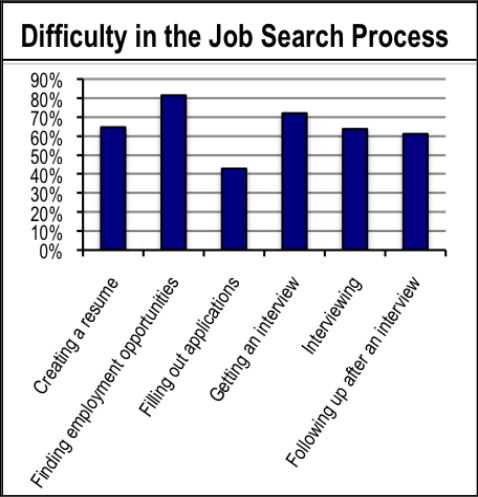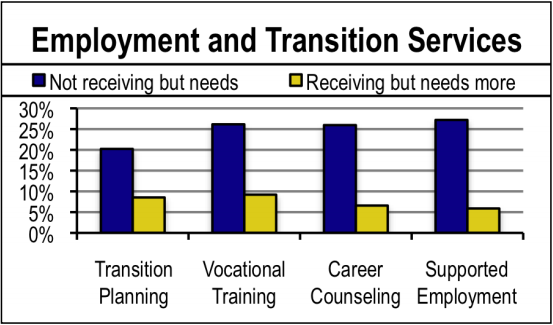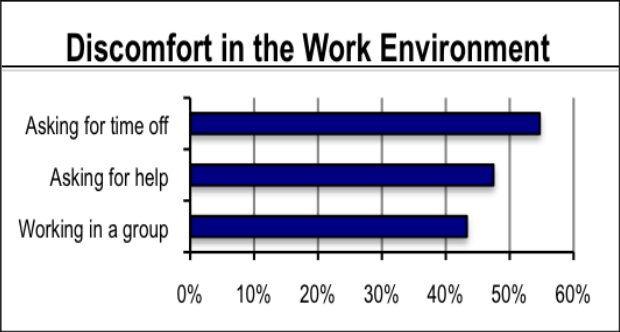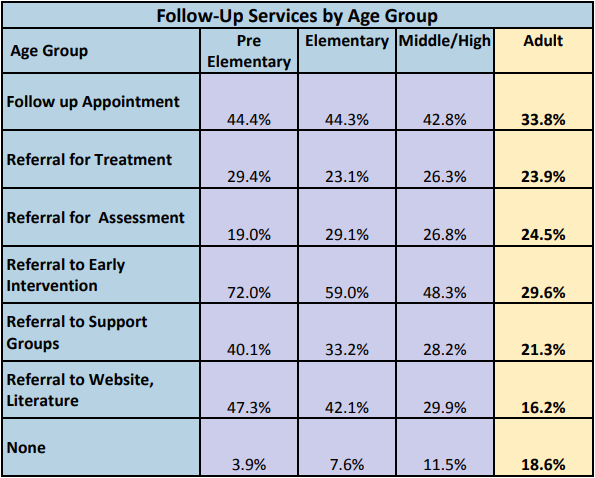
Report #6: Employment Challenges
A Survey of Individuals and Families Living with Autism
About the Autism Needs Assessment
The Bureau of Autism Services, in its effort to improve care and quality of life for Pennsylvanians with autism and their families, conducted the PA Autism Needs Assessment. This effort has been a key task of the ASERT (Autism Services, Education, Resources and Training) Collaborative and has been led by University of Pennsylvania School of Medicine, Center for Mental Health Policy and Services Research and the Center for Autism Research at The Children’s Hospital of Philadelphia.
Autism Spectrum Disorders (ASD), referred to as autism throughout these reports, include Autistic Disorder, PDD-NOS, Asperger’s Disorder, Childhood Disintegrative Disorder and Rett’s Disorder. With more than 3,500 responses, the survey is the largest of its type to date in the nation. The findings from this needs assessment highlight challenges that Pennsylvanians with autism, of all ages, face everyday.
This report is the sixth in a series. The recommendations in this report address employment challenges among Pennsylvanians living with autism.
Why Examine Employment Challenges among Individuals with Autism?
Although many individuals with autism are fully capable of working, most are unemployed or underemployed because the necessary support services are not available to help them find and keep jobs. Finding and maintaining employment is a critical component of improving quality of life. It contributes to meaningful community participation, independent living, and less reliance upon taxpayer-funded programs. Employment services specifically designed to provide the supports that adults with autism need are still very limited, if they are available at all.
Data in this report includes responses from caregivers of adult family members with autism as well as adults with autism who responded for themselves. The overwhelming majority of adults who responded for themselves shared their struggles to find and maintain employment. This report describes their barriers to finding and keeping employment, as well as their current use of employment services. The report concludes with specific recommendations about services in the Commonwealth that will provide Pennsylvanians living with autism the opportunity to find and maintain employment.
Shown here is the employment status of adults who completed the survey. More than 1 in 5 of adults who responded for themselves and 1 in 10 adults for whom caregivers responded were actively seeking employment. Only about 6% of respondents were employed full-time, and about 25% were employed part- time

Employment Challenges
Adults with autism who responded for themselves were asked a series of specific questions about their employment experience. Adults for whom caregivers responded were only asked whether their child was unemployed or employed, and whether they received on-the-job supports. Both groups were asked about employment and unmet need for transition services.

Unemployment & Finding a Job
- More than two-thirds of adults with autism are unemployed. Of those who are employed, most work parttime.
- Finding employment opportunities is the most commonly reported challenge (81%) in the employment process. Other aspects of the employment process were also reported by most as challenging, especially the interview process.
- Regardless of an individual’s skill sets, the social and communication challenges associated with autism affect all aspects of job seeking.
Unmet Need for Employment & Transition Services
- More than 1 in 4 adults with autism report needing, but not receiving vocational training, career counseling or supported employment, and 1 in 5 report needing, but not receiving help with transition planning.
- Approximately 5% to 10% of individuals with autism receive employment and transition services but report needing more than they are provided with.


Interacting with Colleagues in the Workplace
- Only about 25% of employed individuals with autism who responded to the survey for themselves are open about their autism diagnosis in the workplace.
- Almost 70% feel some type of discomfort interacting with their peers and authority figures in the workplace. Many individuals with autism feel uncomfortable asking for time off (55%), asking for help (48%) and working in groups (43%).
Follow-Up Services
- Referrals to follow-up services post-diagnosis have increased over time. Still, less than half of families of pre-elementary school children are referred to treatment or follow-up appointments.
- Caregivers of adults consistently report fewer referrals to follow-up services than other age groups, with almost 19% reporting no referrals at all. Certain services, such as websites, literature and support groups, may not have been available when adults with autism were first diagnosed.

Recommendations
1. Develop accessible employment services that address the specific challenges faced by adults with autism in the workplace.
Adults with autism often have highly specialized skills, can be especially focused in their work life, and can be highly reliable and valued employees. The challenges they face are often in the domains of social interactions with supervisors, colleagues and customers. Effective vocational services for adults with autism would address these challenges and help them find appropriate employment sites, create resumes, perform well during the interview process, and maintain success once employment is secured.
2. Support individuals with autism in the workplace so they can maintain employment.
Individuals with autism may continue to need support in order to maintain employment. On-the-job supports for adults with autism can help bridge the social and communication challenges that affect workplace performance.
3. Create opportunities for dialogue with potential employers about the benefits of hiring individuals with autism.
It is important to gain an understanding of the needs of potential employers, and how to educate those employers on the benefits of hiring individuals with autism. These benefits include decreased hiring and training costs, as well as increased retention, productivity, efficiency, and above average adherence to safety procedures and attendance. Internships and alternative work arrangements, such as telecommuting, could be other useful mechanisms to help individuals with autism gain and maintain employment.
